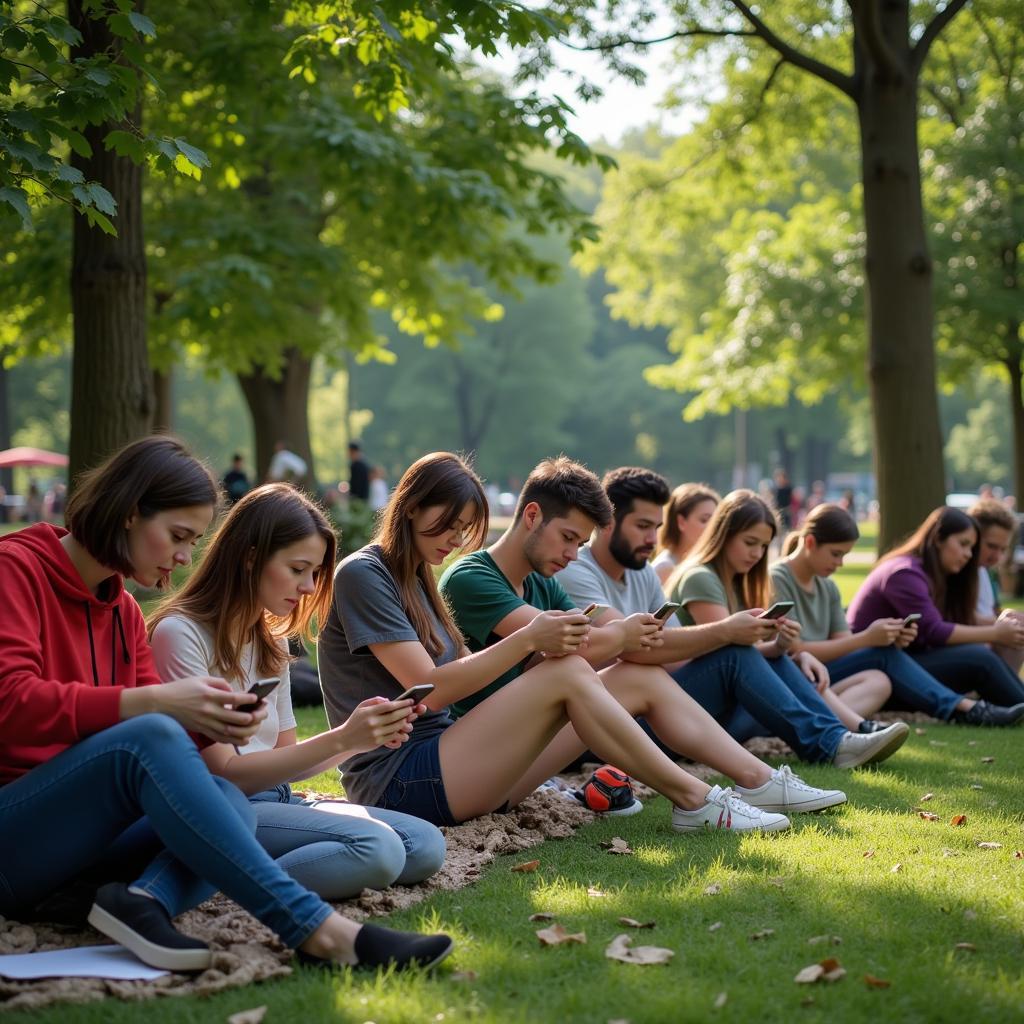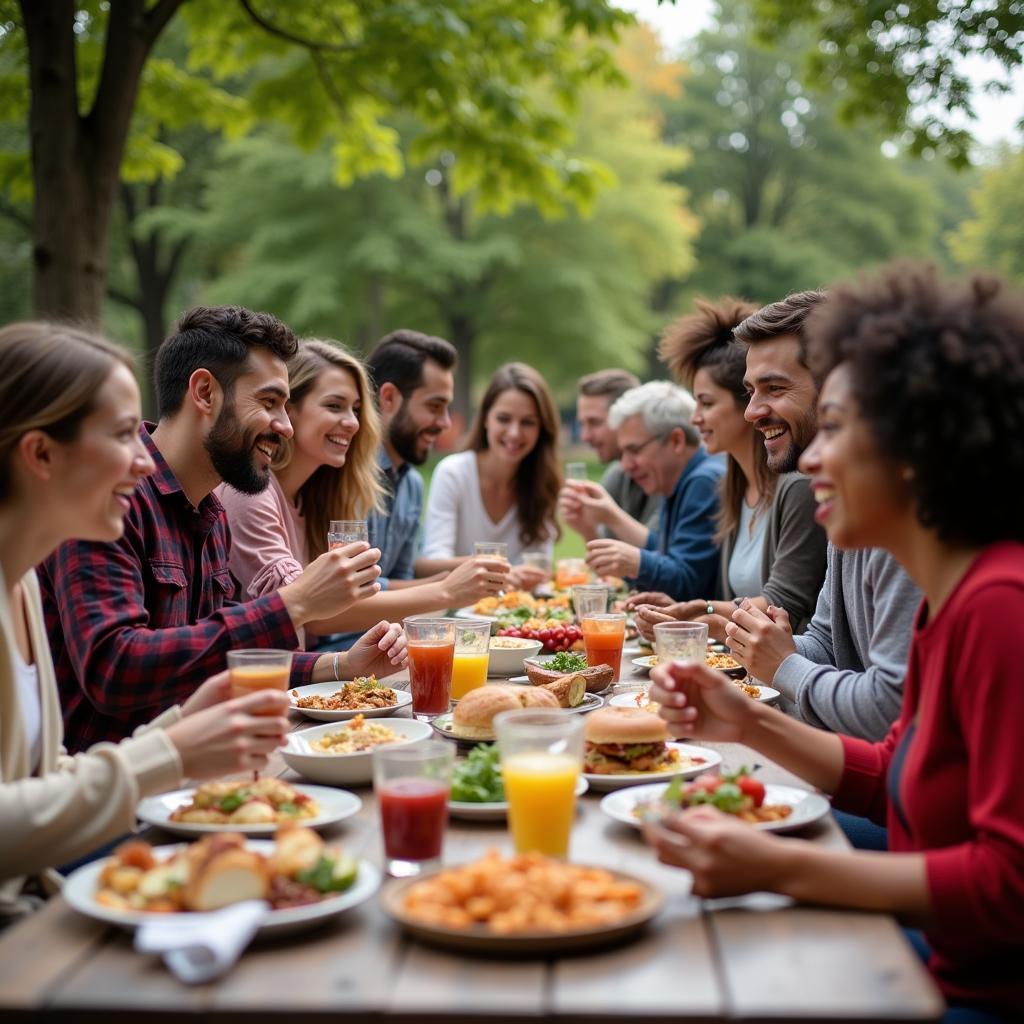The term “Dead Putting Society” might seem strange at first, but it speaks to a growing concern in our modern world. It refers to the idea that we are increasingly prioritizing individual comfort and convenience over communal spaces and shared experiences. We’re retreating into our homes, glued to our screens, and losing sight of the rich tapestry of human connection that once defined our communities. But is this pursuit of comfort truly killing community, or is it simply evolving it?
The Allure of the “Dead Putting Society”
 People glued to their phones in a park
People glued to their phones in a park
There’s no denying the allure of the “dead putting society”. Technology has made our lives undeniably easier. We can order groceries, manage our finances, and connect with friends and family across the globe – all without leaving the comfort of our homes. This convenience, coupled with the ever-increasing demands of modern life, makes it tempting to retreat into our private spheres.
Moreover, the rise of social media has created an illusion of connection. We can curate our online personas, showcasing only the most polished versions of ourselves, and engage in seemingly meaningful interactions through likes, comments, and shares. Yet, these digital interactions often lack the depth and nuance of face-to-face encounters.
The Price of Isolation: When Comfort Trumps Connection
While the “dead putting society” offers undeniable comforts, it comes at a cost. Studies have shown that social isolation and loneliness are on the rise, leading to a range of physical and mental health problems. Without regular, meaningful interactions, our sense of belonging and purpose can dwindle, leaving us feeling disconnected and adrift.
Furthermore, the decline of communal spaces – from local parks and libraries to neighborhood cafes and community centers – further exacerbates this sense of isolation. These spaces once served as vital hubs for social interaction, fostering a sense of belonging and shared identity. As we retreat into our private domains, these spaces often fall into disuse, further eroding the fabric of our communities.
Beyond the “Dead Putting Society”: Reclaiming Connection in a Digital Age
The good news is that the “dead putting society” isn’t an inevitable outcome. We can choose to prioritize connection over comfort, even in our increasingly digital world. Here are a few ways to start:
- Embrace Real-World Interactions: Make a conscious effort to engage in face-to-face interactions, even if it means stepping outside your comfort zone. Attend local events, join a club or group, or simply strike up a conversation with a stranger.
- Support Communal Spaces: Patronize local businesses, volunteer your time at a community organization, or advocate for the preservation of public spaces.
- Be Mindful of Your Digital Diet: While technology can be a powerful tool for connection, it’s important to use it mindfully. Set boundaries around your screen time, be intentional about the content you consume, and prioritize in-person interactions over digital ones.
From Isolation to Engagement: Building a More Connected Future
The “dead putting society” is a cautionary tale, a reminder that true fulfillment comes not from solitary comfort, but from meaningful connection with others. By choosing to prioritize community over convenience, we can build a future where technology enhances, rather than erodes, our shared human experience.
Do you have any thoughts on the “dead putting society”? Share your perspectives in the comments below!
how did the revolver impact society
FAQs
1. What exactly is meant by the term “dead putting society”?
The term “dead putting society” describes a trend where individuals prioritize individual comfort and convenience over communal engagement, leading to a decline in community interaction and shared experiences.
2. How has technology contributed to the “dead putting society”?
Technology has made it easier to live in isolation, with online services replacing the need for in-person interaction. Social media, while offering a sense of connection, can often be a poor substitute for real-world relationships.
3. What are the negative consequences of a “dead putting society”?
A “dead putting society” can lead to increased social isolation and loneliness, negatively impacting mental and physical health. It can also weaken communities and erode social trust.
4. How can we combat the negative effects of the “dead putting society”?
We can combat the negative effects by making conscious efforts to engage in real-world interactions, support communal spaces, and use technology mindfully.
5. Is the “dead putting society” an inevitable outcome of modern life?
No, it’s not inevitable. We have the power to choose connection over convenience and actively build a more engaged and connected future.
 People gathering for a neighborhood potluck
People gathering for a neighborhood potluck
For any support or assistance, please contact us:
Phone Number: 02043854663
Email: [email protected]
Address: Khu 34, Bac Giang, 260000, Vietnam.
Our dedicated customer support team is available 24/7 to assist you.